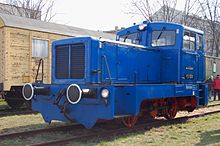DR Class V 15
| DR Class V 15/V 22 DR Class 101/102.0 DBAG Class 311/312 |
|
|---|---|

Preserved first locomotive of DR class V 15
|
|
| Manufacturer | LKM Babelsberg |
| Constructed | 1959/60 (pilot series) 1960 - 1966 (V 15, V 18 B) 1967 – 1976 (V 23, V 22 B) |
| Operator(s) |
Deutsche Reichsbahn Deutsche Bahn |
| Specifications | |
| Car length | 13.55 m (44.5 ft) |
| Wheel diameter | 900 mm, 1000 mm |
| Wheelbase | 2500 mm |
| Maximum speed | 35 km/h (22 mph) (V 15) 42 km/h (26 mph) (V 23) |
| Weight | 20 ... 24 t |
| Axle load | 10 ... 12 t |
| Prime mover(s) | Diesel |
| Engine type | MWJ 6 KVD 18 SRW, ER 6 VD 18/15-1 SRW |
| Power output | 150 PS (110 kW) ... 180 PS (130 kW) (V 15) 220 PS (160 kW) (V 23) |
| Transmission | hydraulic |
| UIC classification | B |
| Braking system(s) | pneumatic |
| Coupling system | Buffers and chain coupler |
| Track gauge | 1,435 mm (4 ft 8 1⁄2 in) |
DR class V 15 and DR class V 23 were diesel locomotives of Deutsche Reichsbahn in the GDR with side-rod drive for light shunting duties.
In order to cover losses incurred during World War II, Deutsche Reichsbahn had some additional Kleinlokomotiven built in the early 1950s. However, a more powerful light shunting locomotive with an engine power of 150 ... 180 PS (110 ... 132 kW) was required to replace the aging Kleinlokomotiven and the steam locomotives used for similar duties. In 1956, LKM Babelsberg presented the new type V 10 B with mechanical gear and a 100 PS (74 kW) engine with wheels of 900 mm (35 in) diameter, based upon the concept of the Kö, but with a higher and closed cab for use on industrial railways and sidings. As this class did not quite satisfy the demands of DR, class V 15 was developed from it. This new class was equipped with hydraulic gears of type GSR 12/3,7 (single torque converter) and originally with 150 PS (110 kW) engines of type 6 KVD 18 SRW. The design model V 15 101 still resembled a Kö II and was not taken into service by DR. Instead, it was sold to Institut für Schienenfahrzeuge Berlin-Adlershof.
In 1959/1960 a pilot series of five locomotives and a first production run of 15 locomotives were built with 150 PS (110 kW) engines and numbered as sub-class V 15.10. Beginning in 1960, further locomotives were built with 180 PS (130 kW) engines as sub-class V15.20-21. This more powerful version of V 15 with 180 PS (130 kW) was also supplied as V 18 B to industrial railways. From V 15 1026 on, the wheel diameter was increased to 1,000 mm (39 in). Several batches of this type were built until 1966.
A second, more powerful series was developed in 1966 with newly developed 220 PS (160 kW) engines of type 6 VD 18/15-1 SRW 1 (Manufacturer: Motorenwerk Roßlau; 6 cylinders, 19 litres (4.2 imp gal; 5.0 US gal), 1510 min−1, 150 mm bore, 180 mm stroke) and a more robust power transmission of type GSU 20/4,5 with two torque converters. Starting in 1967, these locomotives were sold as V 22 B to industrial railways, and from 1968 to 1970 DR took 80 locomotives into service DR as V 23. When the newly developed DR class 102.1 was introduced in 1970, DR stopped purchasing locomotives of this class. Industrial railways continued to procure V 22 B locomotives until 1976. From 1974 on, some were equipped with multiple-unit train controls and automatic engine control so that one driver could operate two coupled locomotives.
...
Wikipedia
